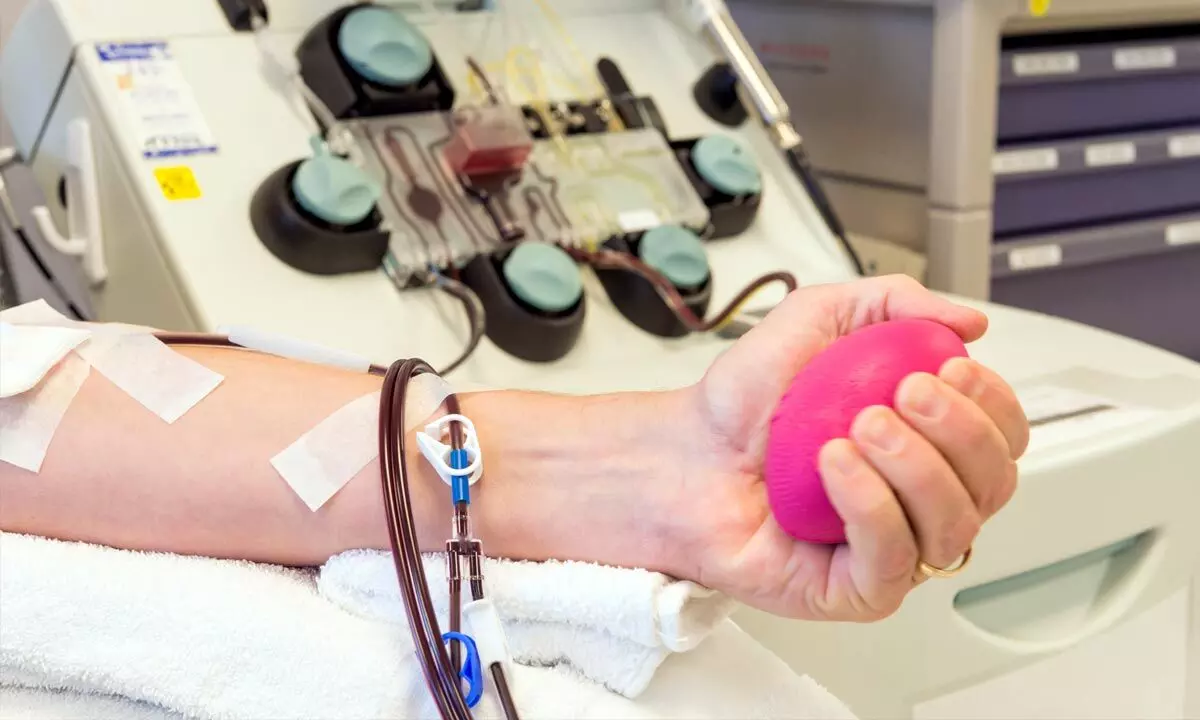Live
- Selection trials for EG kabaddi teams today
- Sorry, says Putin over Azerbaijan crash
- Scholarships to be distributed to students today
- Promote use of Telugu in admin, govt urged
- Govt 'insulted' former PM: Rahul
- Revanth, Naidu & Lokesh to join world leaders at Davos meet
- TTD denies reports on accepting letters from TG leaders
- Afghan forces target Pak in retaliation for deadly airstrikes
- Every district to have cybercrime police station
- 7 lakh devotees to have darshan in 10 days
Just In

Safe blood plays a crucial role in healthcare systems
Safe blood and blood products have a direct and lifesaving impact on countless individuals. The availability of safe blood contributes significantly to reducing morbidity and mortality rates and improving the quality of life for patients in need. Every two seconds, someone in India needs blood. It is estimated that over 12,000 persons die every day in India due to non-availability of blood. Unfortunately, in our country, many people who need transfusions do not have timely access to safe blood.
Let’s look at some facts about safe blood donation shared by Dr. Gautam Wankhede, Director of Medical Affairs, Mylab Discovery Solutions:
• Safe blood is essential in all healthcare facilities to ensure appropriate treatment and minimize preventable mortality. One in four maternal deaths in India is due to excess loss of blood and shortage of blood in hospitals to replenish lost blood. This problem is further compounded by the high prevalence of anaemia in India. More than 1 million new people are diagnosed with cancer each year. Many of them will need blood, sometimes daily, during their chemotherapy treatment. A single-car accident victim can require as many as 100 units of blood.
• Blood safety relies deeply on finding the correctly matched compatible blood in a timely manner that has been accurately screened for transmissible infections. Transfusion Transmitted infections (TTIs) are of significant concern for blood safety. In India, serological screening is mandatory for all donated blood for hepatitis B virus (HBV), hepatitis C virus (HCV) and human immunodeficiency virus (HIV), Malaria, and Syphilis. Out of these, the first three are the most critical. Out of the above, in the case of HIV, HBV, and HCV, the window period, where the screening result can be negative in spite of the presence of infection in the blood donor, is an important factor. The current mandatory screening tests for blood donors in India for the above infections are based on serological techniques (not molecular) and this would mean that donors in the window period of infection may not be detected thereby increasing the risk of TTIs for those who receive blood.
• The prevalence of HIV, HBV, and HCV in India is much higher than in most of the developed world.
• By adopting Individual Donor Nucleic Acid Testing (ID-NAT) across all blood banks, India can potentially prevent about 90,000 new infections every year.NAT is a highly sensitive molecular testing technique that amplifies and detects the genetic material of pathogens in donated blood. It helps identify infections during the early stages, reducing the risk of transmission through transfusions. NAT has significantly improved blood safety by shortening the ‘window period’ when infections may be undetectable using traditional screening methods.
• Blood shortages can occur due to various factors, such as increased demand during emergencies or natural disasters, lower donation rates during holidays or vacation periods, and challenges in maintaining an adequate supply of rare blood types. These shortages highlight the importance of regular blood donations to sustain blood banks throughout the year.
• One donation can save up to three lives.
• Blood donations are not solely used for direct transfusions. Blood can be processed into various components, including red blood cells, plasma, platelets, and cryoprecipitate. These components undergo further processing to create essential blood derivatives used in treating specific medical conditions such as hemophilia, immune disorders, and burns.
• Donated blood has a limited shelf life. Red blood cells, for example, can typically be stored for up to 42 days. Platelets, which are responsible for blood clotting, have an even shorter shelf life of around five days. This limited shelf life emphasizes the ongoing need for regular blood donations to maintain an adequate supply.
• Donating blood from time to time is linked to lower blood pressure and a lower risk for heart attacks as per some studies. People with a condition called hereditary hemochromatosis must have blood removed regularly to prevent the build-up of iron.
• Blood safety relies on public awareness and education. Promoting knowledge about the importance of blood safety, encouraging regular blood donations, and addressing common misconceptions help build a strong culture of blood safety within communities.
In conclusion, safe blood plays a crucial role in healthcare systems, and its availability relies on voluntary unpaid donations, rigorous testing, and careful screening procedures. Blood safety is a multifaceted process that encompasses stringent donor screening, comprehensive testing for infectious diseases, advanced technologies like NAT and pathogen reduction, proper blood typing, storage, transportation, and adherence to quality control measures.

© 2024 Hyderabad Media House Limited/The Hans India. All rights reserved. Powered by hocalwire.com







